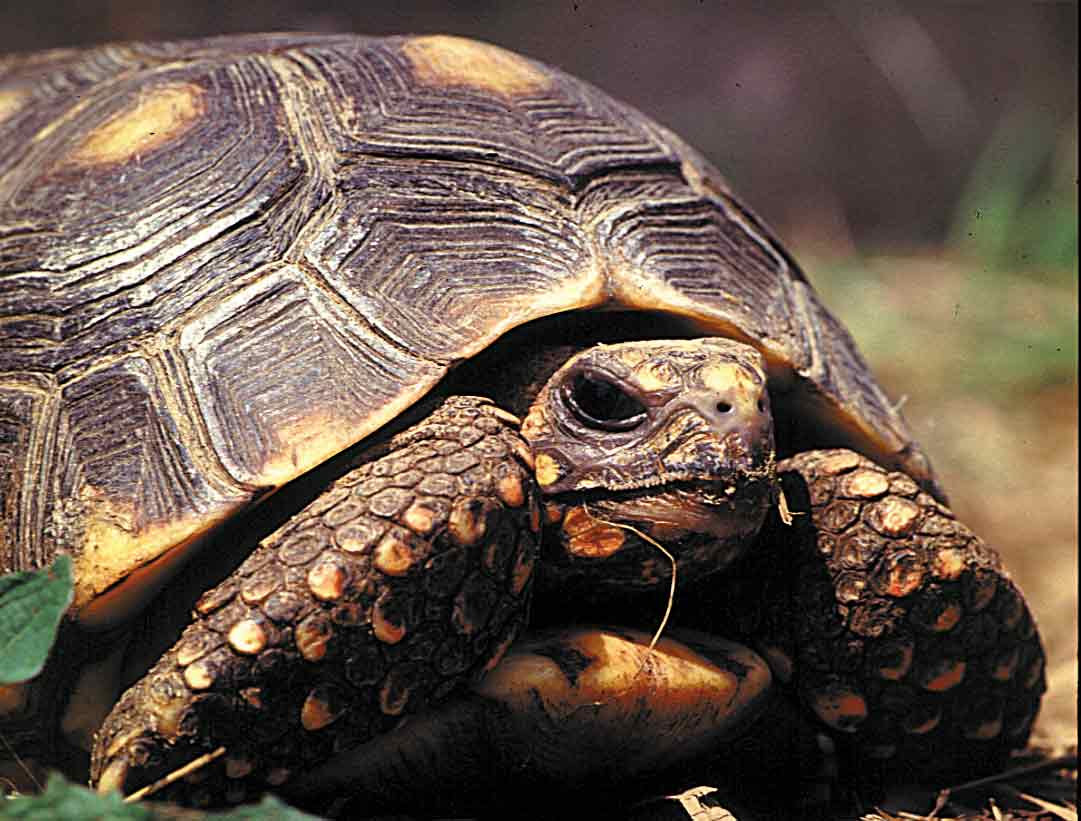
![]() Feeding Red-foot and Yellow-foot tortoises Geochelone carbonaria and G. denticulata
Feeding Red-foot and Yellow-foot tortoises Geochelone carbonaria and G. denticulata
Andy C. Highfield

Both of these large South American tropical tortoises are omnivorous to a greater or lesser extent. Precise tastes and requirements vary, not only between the species, but also seasonally. One study of wild Yellow-foot and Red-foot tortoises revealed some interesting data on the eclectic dietary habitats of these species in Brazil (Moskovits and Bjorndal, 1990). In addition to flowers, leaves and fruits these species were seen to consume:
|
Carrion |
Agouti, peccary, bird, snake, lizard, and deer carcasses. |
|
Live prey |
Snails, ants, termites, bees, beetles, butterflies. |
|
Miscellaneous: |
Mushrooms (several species), sand, soil, pebbles, tortoise feces, bark. |
Other studies, e.g., Castano and Lugo (1981) reported a preference in G. carbonaria for red and yellow flowers. Pritchard and Trebbau (1984) confirmed this by observing G. carbonaria in Venezuela. Fruits remain the main component in the diet of this species, however, comprising up to 70% of the total intake during the wet season and approximately 40% during the dry season. Fruits are normally consumed in a very ripe state after they have fallen from the tree. Some wild species consumed include: Pasiflora coccinea, P. vespertilio, Ficus sp., Philodendron sp., Spondias luteas, Duguetia surinamensis, Mauritia flexuosa, Pouteria hirta and Brosimum potabile. After fruits, flowers are the second most popular food of the Red-foot tortoise. Favoured flowers in the wild include Jacaranda copaia, Mauritia flexuosa and Cholospermum orinocense. During the dry season, such flowers constitute up to about 25% of the diet of this species. The rest of the diet (about 20%) is comprised of green leaves and stems and, (a further 20%) miscellaneous fungi, mosses, termites and carrion.
In captivity, include some low-fat animal protein in the diet of these species to reflect their omnivorous preferences. Protein (or more probably, an amino-acid) deficiency has been noted in some Red-foot and Yellow-foot tortoises raised on entirely herbivorous diets – symptoms have included locomotion difficulty and apparent neurological problems. We recommend re-hydrating dried cat foots with additional minerals and vitamins as for turtles. Provide one meal per week containing animal protein. Avoid high-fat canned foods, however. We now give about 25g of moist cat low-fat cat food to a full grown (9 kg) tortoise on a weekly basis (proportionally less for juveniles). Fruits are also part of the diet of these species in the wild. As discussed above, unlike Leopard or African spurred tortoises, their digestive tract copes easily with this richer, sweeter, higher carbohydrate intake. In captivity, avoid over-reliance on banana: watermelon, papaya, guava, plums, pineapple and cantaloupe are all far more suitable.
A diet that would prove disastrous to a Leopard tortoise is likely to prove optimal for a Red-foot or Yellow-foot tortoise. For the same reason, attempting to sustain a Red-foot tortoise on a diet of mixed grasses would not be advisable; this species is ill equipped to effectively metabolise large quantities of silica-rich grass. One consequence of the higher protein, higher purine content diet of Red-foot and Yellow-foot tortoises is that they must always have access to fresh drinking and soaking water, and must be provided with adequately humid enclosures or terraria. Dehydration is a very serious hazard to any tortoise consuming higher protein and purine content foods (mushrooms, for example). It is no coincidence that all species with this class of dietary preference occur in high rainfall, high humidity ecosystems with regular access to free water. This is reflected not only in their digestive tract biochemistry, but also in the manner in which they eliminate the waste products of the protein metabolism; tortoises from habitats where water is plentiful are predominately aminoureoletic, excreting a combination of ammonia and urea, while tortoises from arid environments are predominantly uricotelic, excreting uric acid and urates. In practical terms, both species require high humidity maintenance and very high fruit content diets that include a small quantity of low fat animal protein. As with all tortoises, they also require a high ratio of calcium to phosphorus, additional trace elements and vitamin D3. Red-foot and Yellow-foot tortoises do not bask to the same extent as arid-habitat species, and therefore obtain much of their D3 needs in nature from the animal component of their diet. In this, they closely resemble African Hinge-back species of the genus Kinixys – which they closely approximate not only in dietary preference, but also in terms of occupying very similar habitat niches.
References and Recommended Reading
Feeding your Tortoise - Avoiding Dietary Disasters
Castano, O. and Lugo, M. (1981) Estudio del comportamiento de dos especies de morrocoy: Geochelone carbonaria y Geochelone denticulata, y aspectos comparables de su morfologia externa. Cespendesia, 10:55-122.
Highfield, A. C. (2000), The Tortoise and Turtle Feeding Manual, Carapace Press (http://www.vidi-herp.com)
Moskovits, D. K, and Bjorndal, K. (1990) Diet and Food Preferences of the tortoises Geochelone carbonaria and G. denticulata in northwestern Brazil. Herpetoogica, 46:207-218
Pritchard, P. C. H., and Trebbau, P. (1984) Turtles of Venezuela. S.S.A.R.
(c) A. C. Highfield 2000-2002